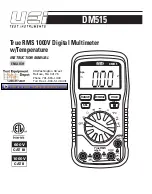
AUBER INSTRUMENTS
WWW.AUBERINS.COM
2017.01
P4/5
Relay on
Relay on
PV1
PV1
SV1
AL1
AH1
AH1
AL1
SV1
Figure 6. Absolute high alarm on J1. Figure 7. Absolute low alarm on J1.
D.2.b) How to change parameters under code 0001.
The procedure for setting Alarm Parameters is similar to Basic Parameters
showed in Figure 4 except the access code is 0001.
D.3 System Parameters
(Press SET then enter 0036 to enter)
Parameters related to peak value recording, display brightness, and input
calculation function are grouped under access code 0036.
D.3.a) Parameter Description
Table 6. List of System Parameters.
Symbol Name
Description
Range Initial Note
MA1
MA1
Peak Value 1
on/off
on
MAt1
MAt1
Timestamp of MA1
on/off
off
7
MA2
MA2
Peak Value 2
on/off
on
MAt2
MAt2
Timestamp of MA2
on/off
off
7
Clr
Clr
Peak Value Clear
on/off
off
8
Bt-l
bt-L
Brightness level -- Low
1 - 2
1
9
Bt-h
bt-H
Brightness level -- High
3 - 4
4
9
Fun1
fun1
Function 1: Calculate Input
Difference
on/off off 10
End
End Exit
Note 7
. When
MA1
(or
MA2
) is set to “off”, setting for
MAt1
(or
MAt2
) will be
ignored.
Note 8
. When
Clr
is set to “off” (default), the controller will keep all the peak
values even the power is lost. When
Clr
is set to “on”, current peak value will
be reset when you reboot this gauge.
Note 9
. There are totally 4 brightness levels of the LED display, from 1 to 4, the
higher the number, the brighter the display. The brightness of the LED display
can be switched between Low (dimmed) and High. The parameter “
bt-L
”
defines the brightness level of the dimmed display, while the parameter “
bt-H
”
defines the brightness level of the bright display. Supply a 12 VDC signal at
terminal 8 or press the UP key (“
∧
”) on the key pad will switch the display level
between bright and dimmed display. Please note, you need to switch the
brightness level once (press the UP key) to activate the new brightness level
settings.
Note 10
. This parameter defines whether to enable Function 1, which
calculates the arithmetic difference between the readings of two input channels
(i.e., Channel 1 - Channel 2). By default, this parameter is set to “off”. When
“
Fun1
” is set to “on”, user can view the calculation result in the lower window
by pressing the DOWN arrow key. Press the DOWN key again will switch the
lower display back to the probe reading. Please see section
D.3.g
in this
manual for details.
D.3.b) How to Change the Parameters Under Code 0036.
The procedure of setting Peak Value Parameters is similar to the Basic
Parameters showed in Figure 4 except the access code is 0036.
D.3.c) Check the Peak Value
To check the Peak Value during operation mode, use the SHIFT key “>”. Press
“>” once, the PK1 indicator will be on,
MA1
and
MAt1
will be displayed in the
upper and lower window respectively. Press “>” key again, the PK2 indicator
will be on,
MA2
and
MAt2
will be displayed in the upper and lower window
respectively; press “>” again to exit this mode and return to the Normal
Operating Mode.
D.3.d) Reset the Peak Value
Current Peak Values will be automatically reset when this gauge is powered
off. To reset them manually, change display to show
MA1
,
MAt1
,
MA2
, and
MAt2
. Then, press and hold DOWN key “V” for 3 seconds. The display will
show “----“ , indicating the memory (for all four peak parameters) is cleared.
The gauge will start to catch the new peak after 2 seconds.
D.3.e) Timer of Peak Values
If MAt1 (or MAt2) is set to “on” a timestamp will be saved when peak value
MA1 (or MA2) is recorded. The timer starts counting time after the gauge is
powered on. The timestamp will be displayed in seconds if it is less than 9999
seconds; if the timestamp is longer than 9999 seconds, it will be displayed as
Hours.Minutes (HH.MM).
D.3.f) Change the Brightness of the Display
The
bt-L
value decides the brightness level of the dim display, available levels
are 1 and 2. The
bt-H
value decides the brightness level of the bright display,
available values are 3 and 4. There are totally 4 brightness levels of the LED
display, from 1 to 4, the higher the number, the brighter the display. Supply a
12 Vdc signal at terminal 8 or press the UP key (“
∧
”) on the key pad will switch
the display level between bright and dimmed display.
Note: The gauge needs about 1 - 2 seconds to powering up. Supplying a
+12 VDC signal to terminal 8 during the powering up period won’t switch the
display to dim level; on the contrary, remove the 12 VDC signal from terminal 8
will dim the display.
D.3.g) Show Input Difference
This feature calculates the arithmetic difference between the displayed
readings of two input channels, and shows the difference on the channel 2
window:
Input Difference = Channel 1 Reading - Channel 2 Reading.
By default, this feature is turned off (
Fun1
= off). When set
Fun1
= on, this
function is enabled. User can check the calculated result in the lower window
by pressing the DOWN arrow key. Press the DOWN key again will switch the
lower display back to the probe reading. For instance, if Channel 1 is
connected to a RTD probe and it shows 200°F, and Channel 2 is connected to
another RTD probe that reads 80°F. When press the DOWN arrow key, the
lower window will show 120.
Please note that the gauge will calculates the arithmetic difference between
Channel 1 and Channel 2 readings despite that these two readings can have























